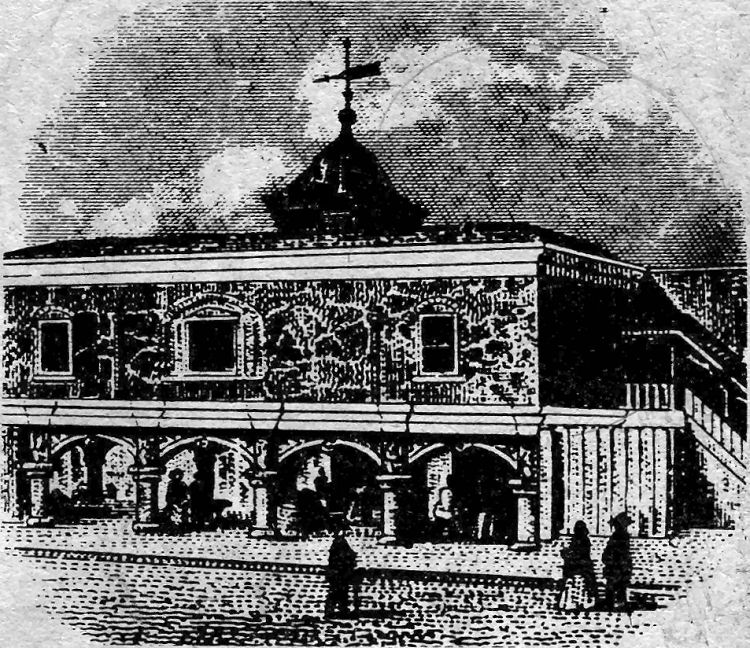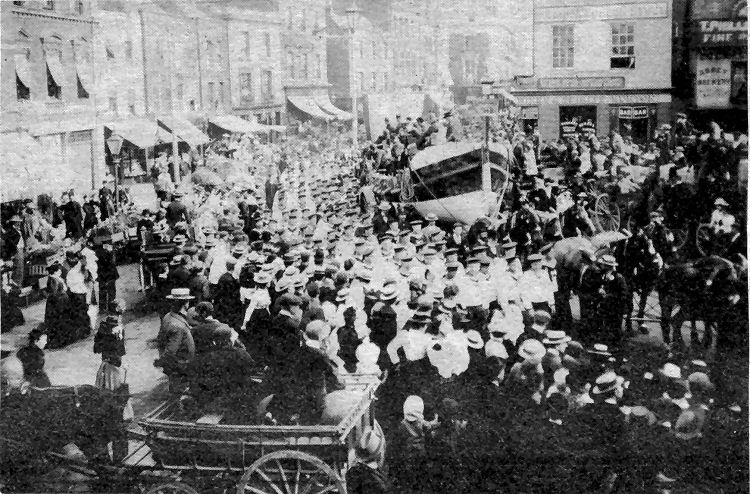Page Updated:- Sunday, 07 March, 2021. |
|||||
 Published in the South Kent Gazette, 27 June, 1979. A PERAMBULATION OF THE TOWN, PORT AND FORTRESS. PART 13.
As regards the history of the south side of the Square, we must be content to begin at a comparatively modem date. The old Guildhall, which stood with its back to this side, was erected in 1605, and first used in 1607. Prior to that date and subsequent to the Reformation, after the dissolution of religious houses, the Corporation held by a questionable tenure a good deal of the land on the south and west sides of the Market Place; and, before the Reformation, they paid to the Priory a rent of four shillings a year for their Court Hall, which, it is supposed, was located somewhere between the Market and Queen Street. 
Above shows a rare engraving of the old Guildhall, in the Market Square, which we have been unable to date, this differs from other well known views in that it does not show the building as seen from the north, as they do, but features the stairway to the court hall above the market stalls. These stairs were at the rear together with an extension made to accommodate the old paving commissioners.
It is quite certain that before the building of their Guildhall in the Market Place, the Corporation considered that they had a right both to the surface of the Square and to the old Almshouse (later the Seamen’s Hospital), at the southern comer of Market Lane. It is equally certain that after they had built their Guildhall, they had to admit that James Hugessen, a merchant adventurer, of Dover, had a superior claim to theirs, on the admitting of which claim the whole area, including the ancient almshouse on the side of Queen Street, was formally conveyed by deed of gift by Hugessen to the Corporation. By that gift the Corporation were established in their Guildhall, and also in the possession of the land on the south of it. From that time for many years after the whole of that side of the Market Place, from Gaol Lane to Market Lane, was, as far as the ground was concerned, the property of the Corporation; but they seem to have granted leases, which, in time, developed into a tenure that it was not easy to terminate.
MARKET PLACE GAOL. In 1746 the old system of using the towers on the town walls as prisons was abandoned, and it was resolved to build a town gaol on the south side of the Market Place, when the Corporation paid £260 for a house there, which they fitted up as a prison. In the building of this — the first town gaol — there was some labour trouble. The Corporation records mention that: "The Committee, on account of the very high wages of the workmen of the town, and their demands for allowances, had thought proper to offer 2/6 a day to the carpenters and bricklayers, and 1/6 a day to the labourers without any allowances, and that the carpenters and labourers were willing to work at that price, but the bricklayers refused to do so.“ The men to whom these terms were offered were Freemen of Dover, but in consequence of this bricklayers’ strike — the first, we believe, on record — the Assembly ordered that bricklayers, whether Freemen or not, who would work cheapest were to be employed. That prison, probably in consequence of the dearness of labour, was not very well built, and it had to be partially re-built fourteen years later, when the frontage towards the Market Place was made more grimly ornate, with courses of strong masonry, upholding a strong semicircular arch which seemed to support nothing, and on either side hung shackles as a warning to evil-doers. Writing about this old prison, in 1812, the Rev. John Lyon said: “The jailor’s house, the prison, and the bridewell are near the staircase leading to the Court Hall, but the two latter are old and indifferent buildings.“ This old prison, which looked a great deal stronger than it was, on the 26th May, 1820, was wrecked by a mob for the purpose of liberating the crew of a Folkestone smuggling galley who were there confined. In the same year, the prison was re-built on the same sate, and continued to be used until 1834, when the Corporation built a new prison at the Maison Dieu.
NEW MARKET AND MUSEUM. The now derelict Covered Market, above which for many years was the municipally-run Museum until it was badly damaged in the 1939-45 war, stands on the site of the old gaol and, being the separate estate of the local magistrates, was sold by auction. The sale was postponed till September, 1837, when the Corporation Market Committee were the purchasers for £555, a new Market being then in contemplation, but, on further consideration, they could not see their way to financing the project. Soon after, they seem to have re-sold the Queen Street frontages — a want of foresight which necessitated re-purchasing at a later date; but the remainder of the site was kept in hand by the Corporation. The project of building the Market and Museum was revived at the annual meeting of the Town Council in 1845, and in April, 1846, Mr. Woodthorpe brought up a report with elaborate plans showing “an open market with stone piers and arches above, subdivided in the interior by columns of a Tuscan character, comprising a Museum along the whole front and over the centre of the Market, the exterior having Corinthian columns, the interior space being filled with pedimented windows.“ It was estimated that this building would cost £3,000, and it come out during the discussion in the Council that the idea was at some future time to carry the Market and Museum through to Queen Street, which was later done. The tenders for this work came in from ten builders — seven from Dover, two from London, and one from Folkestone, but they were all so much above the architect’s estimate that it was resolved to abandon Caen stone, which had been specified by the architect, and some of the ornamental work. This reduced the lowest tender (which was from Mr. George Fry), to £3,448, and that, with the £555 paid for the site, was the cost of the building. The Museum, which was placed in the upper part of the new building in 1848, had been established in the old Guildhall in 1836, when the Town Council removed its place of assembly to the Maison Dieu. The nucleus of the new institution consisted of the collection which had been gathered at great cost by Mr. Edward Pett Thompson, the first Mayor of Dover under the Municipal Reform Act. The exhibits were greatly increased and varied after the removal to the new building. From 1848 the old Guildhall lingered in the Market Place, until July, 1861, when, with the exception of the old carved wooden pillars, joists, beams, the fire bell, and a drinking fountain, the ancient structure was demolished. Some of the carved pillars were placed in the Museum. After the Second World War the Museum was re-established under the Town Hall.

A VIEW of the Market Square, looking into King Street, taken during a procession through streets lined with spectators, many standing on farm carts suggesting it was market day. Young sailors marched alongside an old Dover lifeboat, drawn by a team of six horses, followed by members of Dover Friendly Society. Tramway standards date the picture as post-1896. [Pictured on the corner of King Street is Burton’s "Fountain Hotel" and, next door, the "Duchess of Kent Inn." One sign on the "Fountain" advertises “MacDonald’s Teeth Guaranteed.“
|
|||||
|
If anyone should have any a better picture than any on this page, or think I should add one they have, please email me at the following address:-
|
|||||
| LAST PAGE |
|
MENU PAGE |
|
NEXT PAGE | |